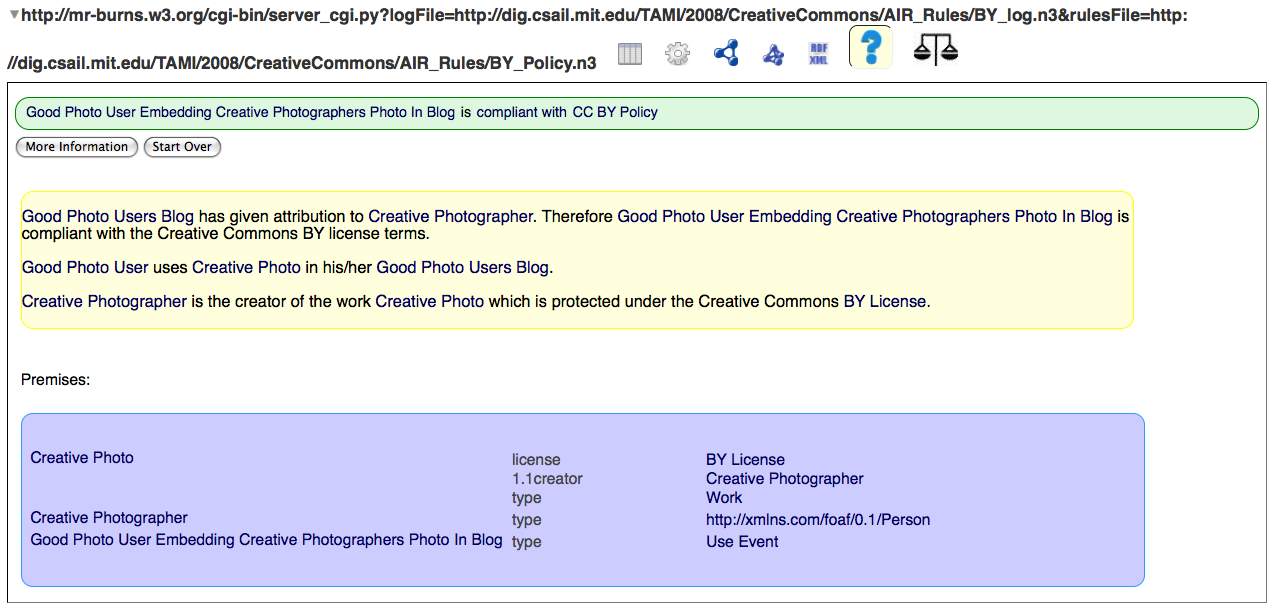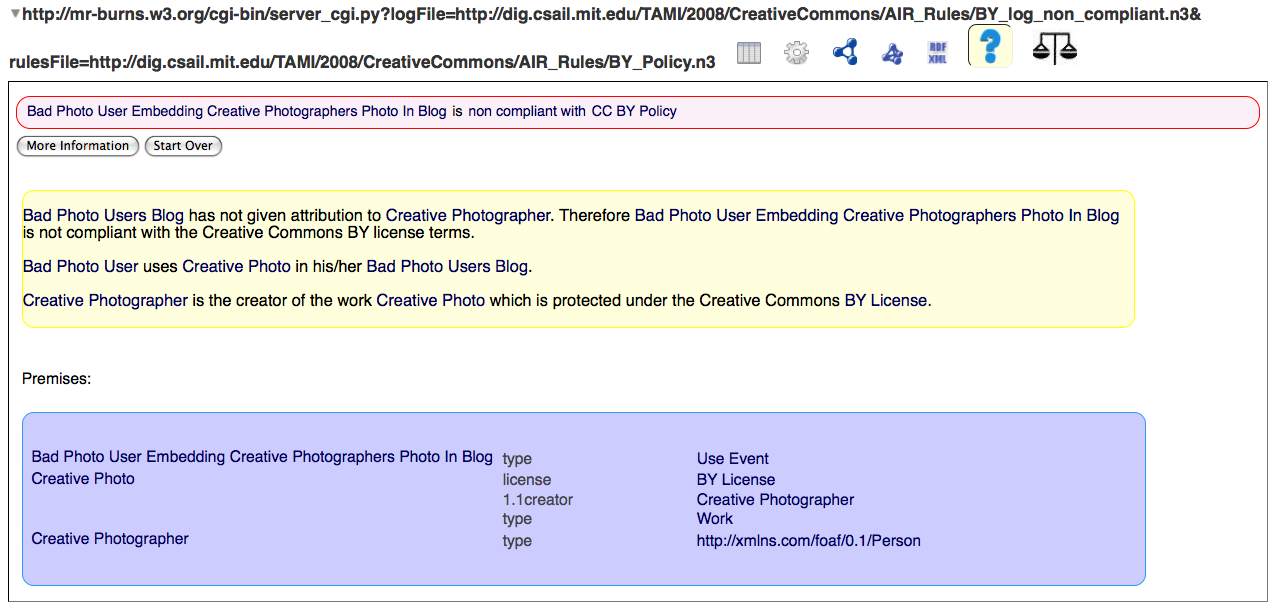Architecture of Accountable Systems
28 August 2008
Bergen University Department of Information and Media Studies
Daniel J. Weitzner
Decentralized Information
Group
MIT Computer Science and Artificial Intelligence Laboratory
These slides: http://dig.csail.mit.edu/2008/Talks/0827-account-arch-bergen/
Talk Overview
- Motivation
- Information Accountability Defined
- An illustrative scenario
- Technical Approach
- Accountable Systems Architecture
- AIR Policy Language and Dependency tracking
- Explanation generation
- Respective Roles of Technology and Law
Motivation

Jerrigan and Mistree (2007), unpublished research
Traditional Computer and Network Systems Understanding of Privacy
“The term “privacy” denotes a socially defined ability of an individual (or organization) to determine whether, when, and to whom personal (or organizational) information is to be released.”Saltzer and Schroeder, The Protection of Information in Computer Systems Communications of the ACM 17, 7 (July 1974).
Privacy Re-Defined - Saltzer and Schroeder revisited
Privacy is the claim of individuals, groups, or institutions to determine for themselves when, how, and to what extent information about them is communicated to used by others.
Information Accountability Through Policy Aware Systems
Information Accountability: When information has been used, it should to possible to determine what happened, and to pinpoint use that is inappropriate
Weitzner, Abelson, Berners-Lee, Feigenbaum, Hendler, Sussman, Information Accountability, Communications of the ACM, Jun. 2008, 82-87
Public Health Investigation Scenario
The U.S. Center for Disease Control (CDC) investigates a case of Extra Drug Resistant Tuberculosis
- The patient is in a coma and can’t be asked about his contacts (the potential spread of the disease)
- The CDC uses data mining techniques to try to determine the patients possible contacts
- A phone company that was source of information for CDC data mining refuses to send a service technician to a person who was a possible contact of the patient.
Demo Scenario
|

|
MA Disability Discrimination Law
No otherwise qualified handicapped individual shall, solely by reason of his handicap, be excluded from participation in, be denied the benefits of, or be subject to discrimination under any program or activity within the Commonwealth
More info: http://www.mass.gov/legis/const.htm#cart114.htm
:MA_Disability_Discrimination_Policy a air:Policy;
air:variable :EVENT, :REQUESTER, :ACTOR, :REASON, :REQUEST, :INSTRUCTION;
air:rule [
air:pattern {
:EVENT a tami:RefuseRequest;
tami:reply-to :REQUEST;
tami:receiver :REQUESTER;
tami:reason :REASON.
};
air:rule [
air:pattern {
:REQUEST tami:instruction :INSTRUCTION;
a tami:Request.
:INSTRUCTION tami:intended_beneficiary :REQUESTER;
a tami:BenefitInstruction.
:REQUESTER tami:location tami:MA.
};
air:rule [
air:pattern { :EVENT a tami:RefuseRequest;
tami:reason :REASON.
:REASON tami:category tami:HealthInformation };
air:assert { :EVENT air:non-compliant-with :MA_Disability_Discrimination_Policy }
]
];
].
AIR Demo Screenshot - Log

AIR Demo Screenshot - Policy

AIR Demo Screenshot (Regular View)

AIR Demo Screenshot (Lawyer View)

Architectural Overview -- The Web today

Architectural Overview -- The Web with Information Accountability Mechanisms

|
|
Highlights of AIR Policy Language -- Importance of Explanations
- Explanations for policy decisions allow users to understand how the results were obtained
- Increase trust in the policy reasoning and enforcement process
- Used by policy administrators to confirm the correctness of the policy and to check that the result is as expected
- In the case of failed queries, they can be used to figure out what additional information is required for success
Why aren't proofs enough ?
|

Image courtesy http://clip.dia.fi.upm.es/~logalg/slides/ |
AIR Policy Language
- rule-based policy language for accountability and access control
- explanations for policy decisions through dependency tracking
- customizable explanations, if required
- more efficient and expressive reasoning through the use
of goal direction
- mainly forward chaining
- backward chaining is used to limit search space
- grounded in Semantic Web technologies for greater interoperability, reusability, and extensibility
Dependency Tracking
|
AIR specifications
:Policy1 a air:Policy;
air:rule [
air:pattern { ... };
air:assert { ... };
air:rule [ ... ]
].
|

|
AIR specifications
- Variables (air:variable)
- used to declare variables that can be used inside patterns
- the scope of variable is the container in which it is declared. If the variable is bound before a rule is invoked, it is passed as a constant
- Rule descriptions (air:description)
- list of variables and strings that are put together to provide the NL description
:Policy2 a air:Policy;
air:variable :VAR1;
air:rule [
air:variable :VAR2;
air:pattern { ... };
air:assertion { ... };
air:description (:VAR1, “ is a variable that is declared in :Policy2 and ”, :VAR2,
“ is a variable that is declared in this rule”);
air:rule [ ... ]
.
AIR Tools
- AIR Reasoner
- accepts data + policy
- produces reasoning result of running policy over data
- Available via http
http://mr-burns.w3.org/cgi-bin/server_cgi.py?logFile="log file"&rulesFile="policy file"
- Justification UI
- accepts reasoning results
- Textual display
- Allows exploration of graphical display
- Firefox Extension: http://dig.csail.mit.edu/2007/tab/
Another application -- copyright licensing with the Creative Commons licensing language

and non-compliance

Respective Roles of Law and Technology in Accountable Systems
- Technical tools are necessary but not sufficient
- Legal rules, especially those defining proper and improper usage, are essential
- Lessons from earlier efforts such as P3P: technical tools can help implement public policy but do not substitute for it.
More Information
- Weitzner, Abelson, Berners-Lee, Feigenbaum, Hendler, Sussman, Information Accountability, Communications of the ACM, Jun. 2008, 82-87.
- Lalana Kagal, Chris Hanson, and Daniel Weitzner, Integrated Policy Explanations via Dependency Tracking, IEEE Policy 2008
- AIR specifications: http://dig.csail.mit.edu/TAMI/2007/AIR/
- AIR ontology: http://dig.csail.mit.edu/TAMI/2007/amord/air.ttl
- Demo: http://dig.csail.mit.edu/2008/Talks/0518-SemTech-eplk/code/
- How to use the Justification UI http://dig.csail.mit.edu/TAMI/2008/JustificationUI/howto.html
